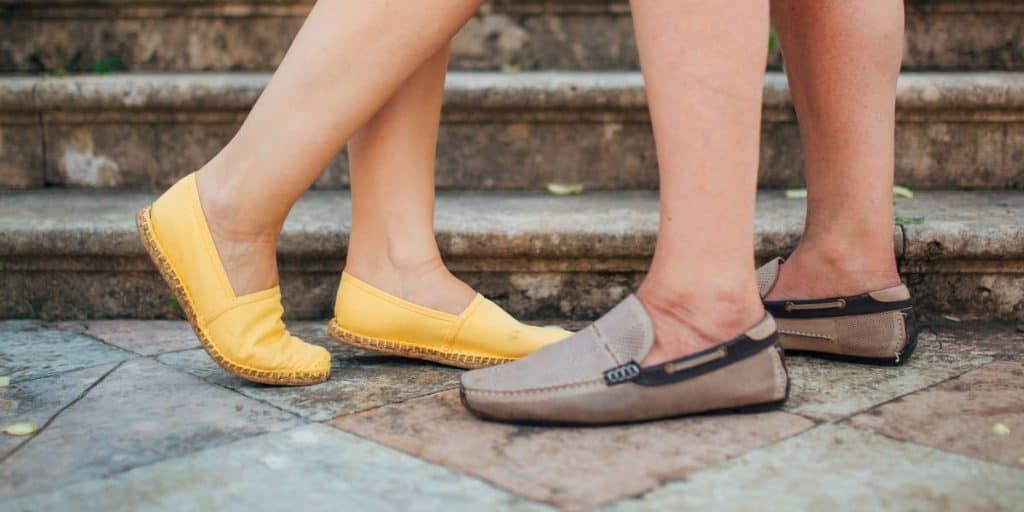Understanding the difference between men’s and women’s shoe sizes can be crucial for finding the perfect fit, especially when shopping for athletic shoes or safety footwear. While men generally have larger feet, the sizing systems themselves differ significantly, making a direct comparison more complex than it seems. This article delves into the nuances of men’s and women’s shoe sizing, exploring the key differences and offering a simple conversion guide.
 Close up on the shoes of a man and a woman
Close up on the shoes of a man and a woman
Decoding the Differences in Men’s and Women’s Shoe Sizing
The primary difference between men’s and women’s shoe sizes lies in the distinct sizing systems employed. These systems are not interchangeable, with a typical 1.5 size difference between men’s and women’s shoes for the same foot length. For instance, a women’s size 10 often corresponds to a men’s size 8.5.
However, this is just the beginning. Variations exist even within gender categories. Half sizes are more prevalent in women’s shoes, and shoe width, indicated by letters (A being the narrowest, E the widest), varies considerably across brands and gender. A “medium” width for women is a B, while for men, it’s a D. Finding the right fit involves understanding these subtle but important distinctions.
Beyond Size: Anatomical Differences in Men’s and Women’s Feet
Beyond the numerical differences in sizing, men’s and women’s feet exhibit distinct anatomical characteristics. Research highlights differences in bone structure, overall shape, and biomechanical function.
Women’s feet, even when accounting for height and weight differences, often have different proportions compared to men’s. For example, a 5’9″ woman’s foot might measure 10.18″ long (a women’s size 10), while a 5’9″ man’s foot might be 10.75″ long (a men’s size 10 or 11).
Furthermore, women tend to have narrower heels and wider forefeet. Studies indicate that 76% of women have wider forefeet relative to their heel, compared to 48% of men. This difference in shape necessitates variations in shoe design for optimal comfort and performance.
Another crucial factor is the Q-angle, the angle formed by the quadriceps muscle and the patellar tendon in the knee. Women generally have wider hips and consequently a wider Q-angle, impacting how their feet strike the ground. Women’s performance shoes often incorporate extra forefoot support to mitigate potential stress fractures and injuries related to this biomechanical difference.
Material and Weight Considerations in Shoe Design
Shoe manufacturers also consider weight and material differences when designing for men and women. Larger, heavier bodies require more robust construction and cushioning.
This is especially evident in running shoes. Men’s running shoes often feature denser cushioning in the midsole to absorb the greater impact forces. While seemingly minor, the weight difference between a men’s and women’s running shoe can impact performance, especially in competitive running.
Choosing the Right Shoe: Gender Considerations
While designed around averages, individual foot variations mean that sticking rigidly to gender-specific shoes isn’t always necessary. Some women might benefit from the extra cushioning in men’s shoes, while men with pronation issues might find better support in women’s footwear.
Additionally, the wider variety of styles and the greater prevalence of half sizes in women’s shoes can influence purchasing decisions. Ultimately, prioritizing comfort and proper fit, regardless of gender designation, is paramount.
Simplifying Shoe Size Conversion
Finding the right shoe fit can be challenging. Ideally, use a Brannock device at a shoe store for precise foot measurements. This device measures length, width, and arch, providing objective data for informed decisions.
If replacing an old pair of shoes, refer to a size conversion chart as a starting point, remembering that width designations also differ. Always try on multiple sizes and widths to ensure optimal comfort and fit. For specialized footwear like steel-toed boots, often considered unisex, men’s sizing standards typically apply. If in doubt consult the manufacturers size guide.
